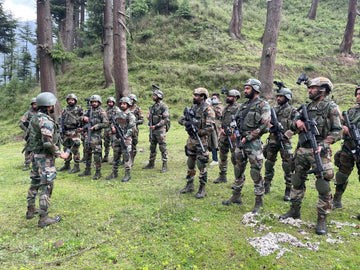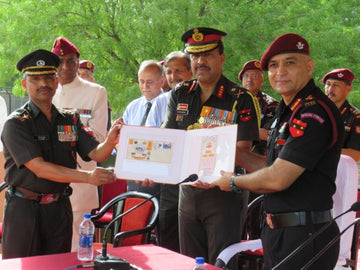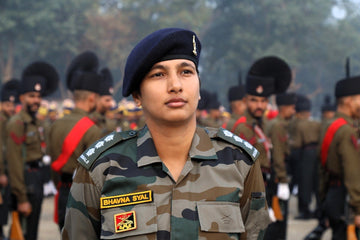Joining the Indian Army as an officer is not just a career path; it is a calling driven by a sense of duty and patriotism to one's nation. With a rich history and exemplary traditions, the Indian Army remains one of the most respected institutions in the country. To become an officer, candidates must navigate through a rigorous and multi-staged selection process that demands not only academic prowess but also exemplary physical and psychological fitness. This article will provide a comprehensive guide on how to become an officer in the Indian Army, covering various entry routes, the selection process, and essential tips for aspirants.
Historical Context
The Indian Army has a storied history, tracing its origins back to the early 18th century, evolving through the British colonial period, and transitioning into an independent force post-1947. With a motto of "Service Before Self," the Indian Army embodies discipline, integrity, and valor. The role of an officer is pivotal in ensuring these values are upheld while leading troops in various capacities, be it in peacekeeping missions, humanitarian assistance, or combat situations. Given the changing dynamics of warfare and security, the recruitment processes have adapted, catering to a diverse pool of candidates who are ready to serve their country.
Main Sections
To become an officer in the Indian Army, applicants can choose from several pathways. Each pathway follows a structured selection process, testing candidates on various fronts.
Territorial Army Officer Recruitment
The Territorial Army (TA) offers a unique opportunity to civilians looking to contribute to the nation while pursuing a civilian career. Here’s how to approach the selection:
Selection Stages:
-
Written Examination: The first step is a computer-based test (CBT) that consists of four sections:
- Reasoning: 25 questions for 25 marks
- Elementary Mathematics: 25 questions for 25 marks
- General Knowledge: 25 questions for 25 marks
- English: 25 questions for 25 marks
Penalty for wrong answers: 0.33 marks for each incorrect response. - Service Selection Board (SSB) Interview: Candidates who clear the written exam are invited for the SSB interview. This involves a variety of tests including psychological assessments, group tasks, and personal interviews to evaluate candidates’ leadership and teamwork capabilities.
- Medical Examination: Following the SSB, shortlisted candidates must clear a thorough medical examination to ensure they meet the physical and mental standards required for service.
- Merit List: Final selections are based on candidates’ overall performance, and vacancies are filled in accordance with merit.
Regular Commission in the Indian Army
For those aiming for a Regular Commission, several entry schemes are available:
National Defence Academy (NDA) and Naval Academy Examination
- Eligibility: Candidates should be 10+2 pass or appearing.
- Selection Process: Involves a written examination followed by the SSB interview and a medical examination.
- Importance: The NDA is a gateway to become a leader in the Indian Armed Forces, nurturing candidates through a three-year training program before they are commissioned.
Combined Defence Services (CDS) Examination
- Eligibility: Open to graduates or those in their final year of graduation.
- Selection Process: It follows a written examination, SSB interview, and a medical exam.
- Significance: The CDS exam ensures a constant influx of qualified officers who can contribute effectively to the force immediately upon commissioning.
Technical Entry Scheme (TES)
- Eligibility: Specifically for engineering graduates or those in their final year of engineering.
- Selection Process: Candidates are shortlisted based on their academic performance before proceeding to SSB interviews and medical examinations.
- Advantage: This route emphasizes the integration of technical expertise within the Army, a necessity in modern warfare.
Short Service Commission (SSC)
- Eligibility: This route is available for graduates and postgraduates.
- Selection Process: Similar in structure to the CDS, including shortlisting based on qualifications and subsequent assessments.
Agniveer Recruitment Scheme
Introduced as a progressive recruitment model, the Agniveer scheme aims to attract young talent to serve in the army for a limited period of four years, thereby increasing the workforce efficiency and adaptability of the army.
Selection Stages:
-
Online Computer-Based Test: Candidates must appear for a CBT relevant to the position, covering General Knowledge, Reasoning Ability, and Technical Skills.
Different exams apply depending on roles like Soldier Clerk, Soldier General Duty, and Soldier Technical. -
Recruitment Rally: Successful candidates from the CBT participate in a recruitment rally that comprises:
- Physical Fitness Test: Measures endurance and physical strength.
- Physical Measurement Test: Assessments of height, weight, and other physical dimensions to ensure compliance with standards.
- Adaptability Test: Evaluates a candidate's ability to adapt to military life and work.
- Medical Examination: A comprehensive check to ensure all health parameters are met.
Eligibility:
- Age: Candidates should be between 17½ to 21 years old.
- Educational Qualifications: Minimum of 45% aggregate marks and 33% in each subject in Class 10th/Matric.
General Application Process
Regardless of the entry scheme, the process begins online:
- Online Application: All candidates must submit their applications through the official Indian Army website. It is crucial to ensure that the applications are submitted within specified timelines.
- Documents Required: Candidates must prepare necessary documents including academic certificates, proof of age, and any additional documentation that may be required based on the chosen entry route.
Key Dates and Deadlines
Being aware of application windows and exam dates is crucial. For instance:
- The online applications for Territorial Army and other regular commissioned entries are announced through official notifications.
- For the 2025 Agniveer Recruitment cycle, applications commenced on 12th March 2025, with examinations scheduled to start from 30th June 2025.
Challenges and Solutions
While the pathway to becoming an officer in the Indian Army is clearly delineated, challenges persist:
- Physical and Mental Preparedness: Many candidates fail to meet the physical fitness standards or struggle with psychological evaluations. To overcome this, aspirants should undertake regular physical training and mental conditioning sessions before the exams.
- Written Examination Preparedness: The competitive nature of written examinations necessitates comprehensive study. Utilizing resources like SSBCrack and SSBCrackExams can provide candidates with valuable insights and preparation materials tailored to the examinations.
- Nervousness During SSB Interviews: SSB interviews can be daunting due to their extensive evaluation. Practicing group discussions and personal interviews with peers or joining coaching programs can help candidates build confidence.
Future Trends and Predictions
The landscape of military recruitment is evolving. There is a noticeable shift towards inclusion and diversity in the Indian Army. Future trends may include:
- Technological Integration: As warfare becomes increasingly technologically driven, the need for officers with advanced technical knowledge will grow. The Indian Army may introduce more tech-centric entry schemes to attract candidates with relevant expertise.
- Gender Inclusivity: The Indian Army has begun to open more roles to women, including combat roles. As societal norms evolve, the inclusion of women may lead to further transformations in recruitment strategies.
- Emphasis on Soft Skills: Leadership and emotional intelligence are set to become vital attributes for Indian Army officers. Future training programs may focus more on developing these characteristics alongside traditional military skills.
Conclusion
Becoming an officer in the Indian Army is an endeavor filled with challenges, dedication, and immense honor. From various entry routes such as the Territorial Army, NDA, CDS, TES, SSC, and the Agniveer scheme, there are ample opportunities for aspiring candidates to serve their nation. Each pathway presents a structured selection process that rigorously assesses physical capabilities, mental resilience, and leadership potential.
Candidates interested in this noble profession must prepare diligently, stay updated on recruitment timelines, and make use of available resources like SSBCrack tools, study materials, and preparatory courses. As one embarks on this journey, the commitment to service, integrity, and leadership becomes paramount.
For those ready to commit to the ideals of the Indian Army, prepare not just for the challenges ahead but for a life of service, where every effort contributes to the greater good of the nation. Joining the ranks of the Indian Army as an officer is indeed a rewarding path, both personally and nationally.





